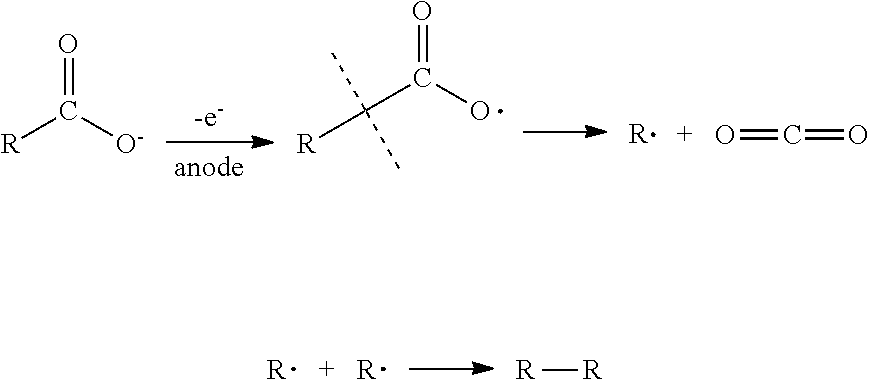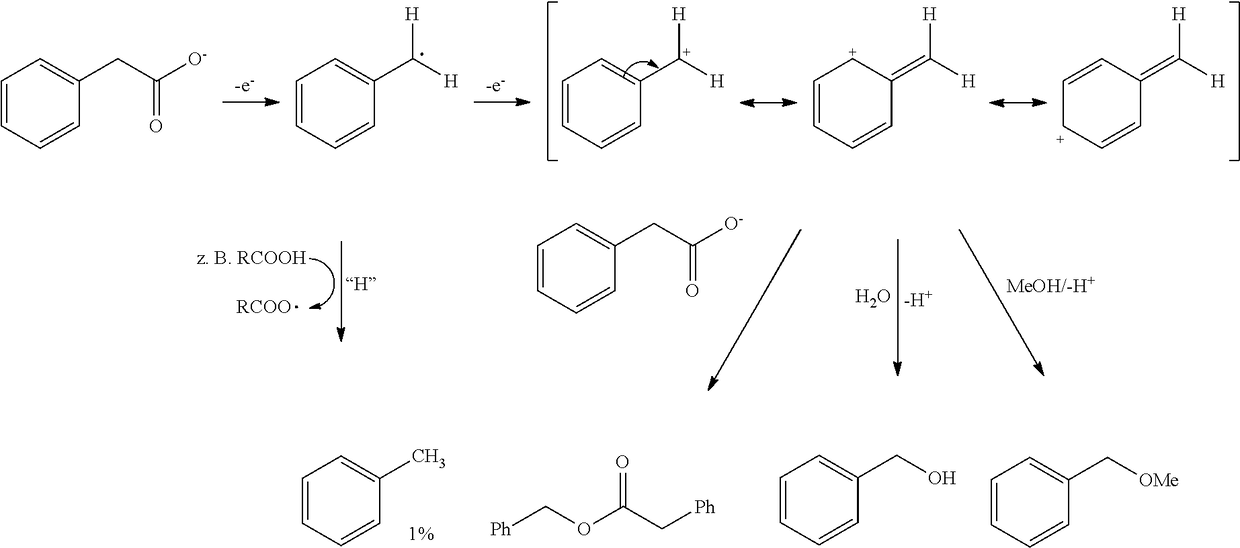Process for producing alkanes using microorganisms combined with kolbe synthesis
- Summary
- Abstract
- Description
- Claims
- Application Information
AI Technical Summary
Benefits of technology
Problems solved by technology
Method used
Image
Examples
example 1
[0131]Clostridium kluyveri Forming Butyric Acid from Acetate and Ethanol
[0132]For the biotransformation of ethanol and acetate to butyric acid the bacterium Clostridium kluyveri was used. All cultivation steps were carried out under anaerobic conditions in pressure-resistant glass bottles that can be closed airtight with a butyl rubber stopper.
[0133]For the preculture 100 ml of DMSZ52 medium (pH=7.0; 10 g / L K-acetate, 0.31 g / L K2HPO4, 0.23 g / L KH2PO4, 0.25 g / l NH4Cl, 0.20 g / l MgSO4×7 H2O, 1 g / L yeast extract, 0.50 mg / L resazurin, 10 μl / l HCl (25%, 7.7 M), 1.5 mg / L FeCl2×4H2O, 70 μg / L ZnCl2×7H2O, 100 μg / L MnCl2×4H2O, 6 μg / L H3BO3, 190 μg / L CoCl2×6H2O, 2 μg / L CuCl2×6H2O, 24 μg / L NiCl2×6H2O, 36 μg / L Na2MO4×2H2O, 0.5 mg / L NaOH, 3 μg / L Na2SeO3×5H2O, 4 μg / L Na2WO4×2H2O, 100 μg / L vitamin B12, 80 μg / L p-aminobenzoic acid, 20 μg / L D(+) Biotin, 200 μg / L nicotinic acid, 100 μg / L D-Ca-pantothenate, 300 μg / L pyridoxine hydrochloride, 200 μg / l thiamine-HCl×2H2O, 20 ml / L ethanol, 2.5 g / L NaHCO3, 0...
example 2
[0137]Clostridium kluyveri Forming Hexanoic Acid from Acetate and Ethanol
[0138]For the biotransformation of ethanol and acetate to hexanoic acid the bacterium Clostridium kluyveri was used. All cultivation steps were carried out under anaerobic conditions in pressure-resistant glass bottles that can be closed airtight with a butyl rubber stopper.
[0139]For the preculture 100 ml of DMSZ52 medium (pH=7.0; 10 g / L K-acetate, 0.31 g / L K2HPO4, 0.23 g / L KH2PO4, 0.25 g / l NH4Cl, 0.20 g / l MgSO4×7 H2O, 1 g / L yeast extract, 0.50 mg / L resazurin, 10 μl / l HCl (25%, 7.7 M), 1.5 mg / L FeCl2×4H2O, 70 μg / L ZnCl2×7H2O, 100 μg / L MnCl2×4H2O, 6 μg / L H3BO3, 190 μg / L CoCl2×6H2O, 2 μg / L CuCl2×6H2O, 24 μg / L NiCl2×6H2O, 36 μg / L Na2MO4×2H2O, 0.5 mg / L NaOH, 3 μg / L Na2SeO3×5H2O, 4 μg / L Na2WO4×2H2O, 100 μg / L vitamin B12, 80 μg / L p-aminobenzoic acid, 20 μg / L D(+) Biotin, 200 μg / L nicotinic acid, 100 μg / L D-Ca-pantothenate, 300 μg / L pyridoxine hydrochloride, 200 μg / l thiamine-HCl×2H2O, 20 ml / L ethanol, 2.5 g / L NaHCO3,...
example 3
[0143]Clostridium kluyveri Forming Hexanoic Acid from Butyric Acid and Ethanol
[0144]For the biotransformation of ethanol and butyric acid to hexanoic acid the bacterium Clostridium kluyveri was used. All cultivation steps were carried out under anaerobic conditions in pressure-resistant glass bottles that can be closed airtight with a butyl rubber stopper.
[0145]For the preculture 100 ml of DMSZ52 medium (pH=7.0; 10 g / L K-acetate, 0.31 g / L K2HPO4, 0.23 g / L KH2PO4, 0.25 g / l NH4Cl, 0.20 g / l MgSO4×7 H2O, 1 g / L yeast extract, 0.50 mg / L resazurin, 10 μl / l HCl (25%, 7.7 M), 1.5 mg / L FeCl2×4H2O, 70 μg / L ZnCl2×7H2O, 100 μg / L MnCl2×4H2O, 6 μg / L H3BO3, 190 μg / L CoCl2×6H2O, 2 μg / L CuCl2×6H2O, 24 μg / L NiCl2×6H2O, 36 μg / L Na2MO4×2H2O, 0.5 mg / L NaOH, 3 μg / L Na2SeO3×5H2O, 4 μg / L Na2WO4×2H2O, 100 μg / L vitamin B12, 80 μg / L p-aminobenzoic acid, 20 μg / L D(+) Biotin, 200 μg / L nicotinic acid, 100 μg / L D-Ca-pantothenate, 300 μg / L pyridoxine hydrochloride, 200 μg / l thiamine-HCl×2H2O, 20 ml / L ethanol, 2.5 g...
PUM
 Login to View More
Login to View More Abstract
Description
Claims
Application Information
 Login to View More
Login to View More - R&D
- Intellectual Property
- Life Sciences
- Materials
- Tech Scout
- Unparalleled Data Quality
- Higher Quality Content
- 60% Fewer Hallucinations
Browse by: Latest US Patents, China's latest patents, Technical Efficacy Thesaurus, Application Domain, Technology Topic, Popular Technical Reports.
© 2025 PatSnap. All rights reserved.Legal|Privacy policy|Modern Slavery Act Transparency Statement|Sitemap|About US| Contact US: help@patsnap.com


